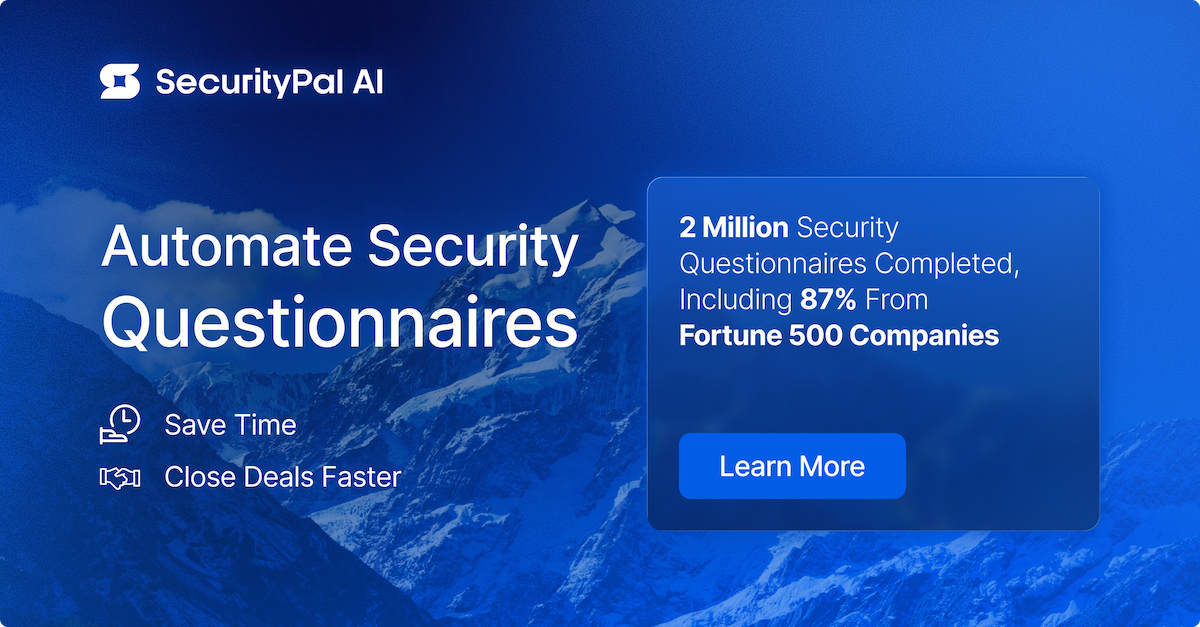A 2025 Guide to Security Questionnaire Automation

Security questionnaires are often one of the most critical — and most frustrating — parts of closing enterprise deals. Ownership is shared across multiple teams. The stakes are high. And without a streamlined process, security questionnaires can quickly become a bottleneck in your sales pipeline.
Despite that friction, security questionnaires are essential to building customer trust. They demonstrate that your organization meets security, privacy, and compliance standards — a non-negotiable in today’s risk-conscious enterprise environment.
The good news? Security questionnaire automation, when implemented correctly, can transform this bottleneck into a competitive advantage — accelerating deal cycles, protecting sensitive data, and freeing up your team to focus on more strategic work.
What are Security Questionnaires?
Security questionnaires are standardized documents used by organizations to assess the cybersecurity, compliance, and risk posture of potential vendors or partners. They typically include hundreds of questions — covering topics like data protection, network security, encryption standards, and access controls. Security questionnaires help organizations ensure third-party vendors meet required safeguards before a business relationship begins.
Questionnaires are often owned and managed jointly by Sales, Security, and GRC (Governance, Risk, and Compliance) teams — making collaboration and process clarity crucial.
Why Security Questionnaires Matter — and Why They’re So Painful
The modern enterprise relies on a complex web of third-party vendors, SaaS tools, and cloud infrastructure. While this enables innovation and scale, it also increases exposure to third-party risk. On average, enterprises work with over 1,000 third-party vendors, and nearly 98% of organizations have a relationship with at least one third party that has experienced a breach.
Security questionnaires help mitigate this risk. They enable organizations to evaluate whether a partner’s security practices are up to par — and where liability lies in the event of a breach. But as vital as they are, security questionnaires can take hours of valuable time away from sales, security, and GRC teams.
For growing organizations, that friction can become a growth killer. Each day a security questionnaire sits incomplete is a day your sales cycle stalls.
How to Streamline the Security Questionnaire Process
Security questionnaires are often hundreds of questions long, covering everything from privacy policies to infrastructure for breach response and physical data server security. So how can you streamline the process on all fronts?
1. Build on Established Frameworks and Certifications
Mapping your security program to widely recognized frameworks can dramatically reduce response time and increase consistency. These frameworks provide pre-validated, standardized language that can be reused across questionnaires:
- CIS Critical Security Controls – Practical, prioritized defensive actions for organizations of all sizes.
- SOC 2 (SSAE 18) – Assesses a company’s controls relevant to security, availability, processing integrity, confidentiality, and privacy.
- ISO/IEC 27001 – A globally recognized standard for information security management.
- NIST SP 800-171 – Federal standard for protecting Controlled Unclassified Information.
- CAIQ/CCM – Tailored for cloud security assessment.
- SIG (Shared Assessments) – Modular questionnaire options (Lite, Core, Basic) based on risk level.
Pro tip: keep your documentation for audits and reviews aligned with these standards. Many questionnaires ask the same core questions — just worded differently.
2. Centralize Responses in a Living Knowledge Base
Security questionnaires aren’t one-and-done tasks. They require input from multiple teams, including IT, legal, sales, security, and GRC. Plus, many companies re-assess vendors at least annually. Without a centralized repository of approved answers, you risk inconsistency, delay, and duplicate work.
Build (or adopt) a secure, regularly updated knowledge library that includes:
- Approved responses to common questions
- Documented policies and procedures
- Audit reports, certifications, and third-party attestations
This foundation allows you to auto-populate responses, ensure alignment across teams, and avoid reinventing the wheel every time a new questionnaire comes in.
3. Automate Intelligently — With Human Oversight
AI and automation are powerful tools for accelerating the security questionnaire process — but they’re not silver bullets.
Standalone AI automation may promise instant answers, but when precision and accuracy are critical, you cannot rely on AI alone. Best-in-class automation strategies include human-in-the-loop workflows. AI tools handle the repetitive, data-driven portions, while experienced security professionals ensure contextual accuracy, nuance, and compliance with industry standards.
SecurityPal’s hybrid approach delivers:
- Faster turnaround (24–48 hours instead of weeks)
- Consistent quality
- Reduced risk of missing key requirements
- Trustworthy responses that hold up under scrutiny
4. Communicate Proactively With Requestors
Not every question will be applicable. Some may be redundant. Others may require context.
Instead of leaving those fields blank or guessing, reach out proactively to clarify expectations. This helps build credibility, prevent back-and-forth cycles, and show that your team takes security seriously — even when an exact answer isn’t straightforward.
Proactive transparency builds trust and keeps the process moving.
Pro tip: To help you get ahead of security questionnaires, SecurityPal Trust Center is your always-on, branded hub to showcase your security and GRC posture — before customers submit a security questionnaire.
Manual vs. Automated vs. Outsourced: What’s Best?
There are three approaches for answering security questionnaires: manually, automation, or outsourcing (AI + human expertise). Let’s break down the pros and cons of each option:
If your team is overwhelmed, outsourcing to SecurityPal gives you the speed of AI with the precision of human experts — a game changer for enterprises. The result? Less friction, more closed deals, and fewer headaches for your GRC and Security teams.
The Bottom Line: Automate Security Questionnaires with SecurityPal
When done right, security questionnaire automation can turn a slow, manual process into a streamlined workflow that supports both security excellence and business growth. That’s not just a win for the security team. It’s a win for Sales, Legal, GRC, and your bottom line.
At SecurityPal, we don’t just automate — we augment. Our team of security experts combines smart automation with deep knowledge of industry frameworks and requirements. We deliver accurate, complete questionnaires in as little as 24 hours, helping our customers close deals faster without compromising on security.






_11zon.webp)







